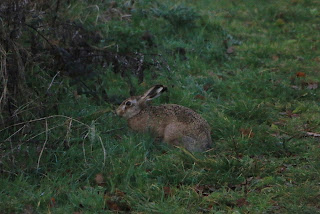The Ashmolean Natural History Society of Oxford is a long established group for people with a catholic interest in natural history and provides a series of lectures and field meetings. Yesterday they organised a walk through the RSPB reserve at Otmoor led by the RSPB warden to see the starling murmuration there.
Around 25 miles from Hook Norton, the reserve at Otmoor was created less than 20 years or so ago when agricultural fields subject to flooding were converted into a semi wetland - some permanent water in reedbeds supplemented by winter flooding of grassland elsewhere. We saw, interalia, wigeon, mallard, Canada and greylag geese, kestrel and red kite, lots of goldfinches and critically examined blackthorn tagged last winter where black and brown hairstreak eggs were found in a survey last winter (but finding nothing). But this was not a twitching trip; the main purpose was to see the vast flocks of starlings which gather around dusk and the murmuration that follows as they begin to roost in the reedbeds.
A bonus was sightings of three hares, one of which sat quietly as I got within 10 metres of it. We did not see any otters, but they are there and we will make another visit in two or three weeks to see if we can spot them.

No comments:
Post a Comment